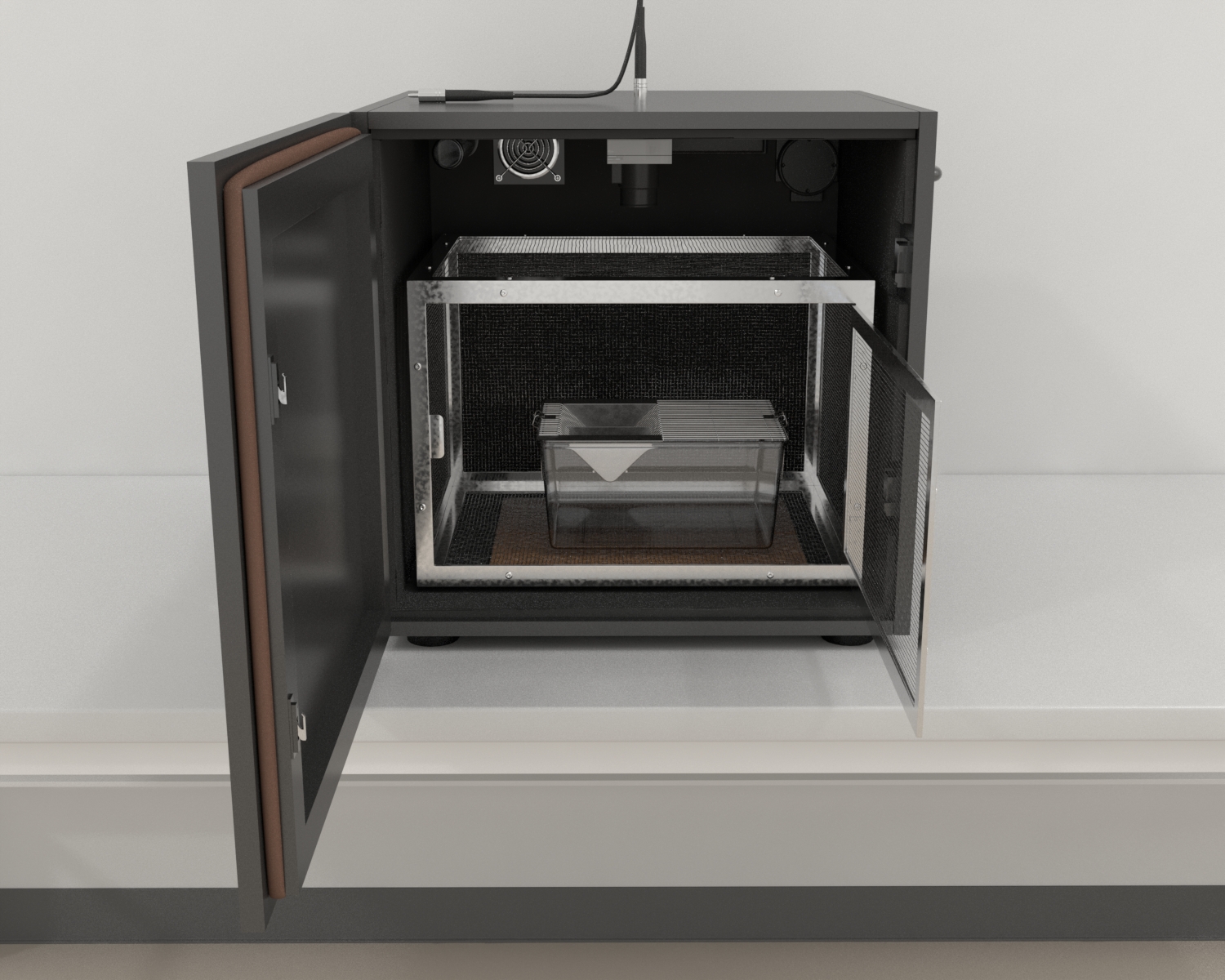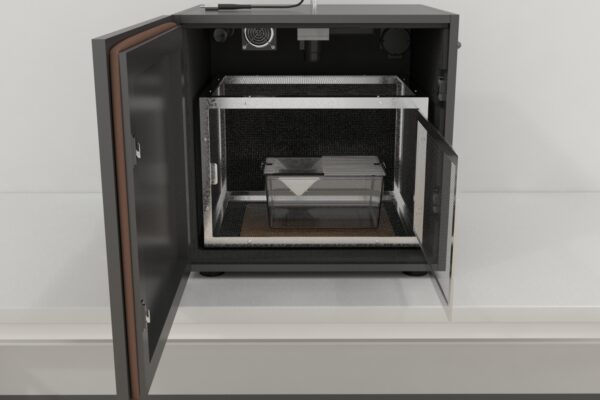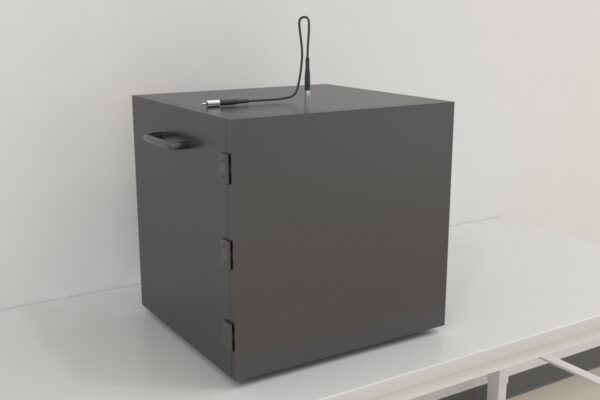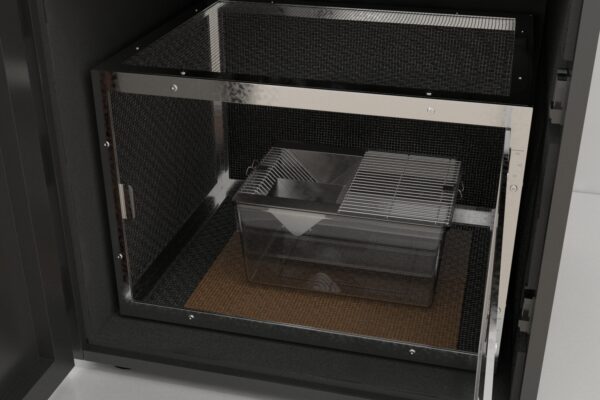Description
The Maze Engineers Rodent Auditory Brainstem Response Test package is used to assess the function of the auditory pathway in the brainstem of rodents. In this offers neurophysiological test, clicks or short tone bursts are presented to the ear and the resulting electrical activity is measured from electrodes placed on the skin over the brainstem. The responses to these stimuli are used to assess the integrity of the auditory nerve and various brainstem nuclei. The ABR test is commonly used to evaluate hearing thresholds in rodents, and can also be used to detect damage to the auditory pathway or to assess the efficacy of drugs or other interventions that may affect auditory function.
Maze Engineers offers Rodent Auditory Brainstem Response Test
Features
Isolation Cubicle:
- 50(w) x 40(d) x 50(h) cm
- Includes an LED light and IR light, camera holder, and external device slot.
- Includes animal enclosure
Maze Engineers control box
- Connects the TDT RZ6 processor to send a TTL signal of voltage (5v duration 100ms) before every stimulus
Sound generator and Stimuli
-
- Tone frequency – 100-20,000Hz frequency
- Volume in decibels up to 130dB
- Duration in milliseconds
- White noise and narrow white noise stimulus: Octave, 1⁄2 Octave, 1/3 octave and 1/6 octave
TDT RZ6 Multi-I/O high-frequency auditory processor
Recieves signals from the Maze Engineers control box before each stimulus (5v, 100ms)
Speakers
- Dual high-quality speakers, one speaker for tone and the other speaker for white noise
- Dimensions: 33(w)*10(d)*18.5(h) cm
Real-time sound lever reader
-
- Sound level reading in decibels is measured in the inner chamber and is displayed on the PC monitor in real-time.
- Sound level meter is able to measure a wider sound frequency range of up to 20K Hz with high accuracy.
Software:
- Conduct ABR Maze software
- Protocol setup: user can specify a sequence of sound stimuli with fields (frequency, dB level, phase, duration)
- Display the sound dB level at run-time
- Sound stimuli include tone, white noise and narrow white noise
- Experiment protocols and results are saved on the PC
- Support up to 4 units simultaneously
- Integration with video tracking software such as EthoVision, ANY-Maze, or Behavior Cloud
Price
Mouse Auditory Brainstem Response Test
$ 24850
Per MonthIncludes:- Isolation Cubicle
- Animal enclosure
- Maze Engineers control box
- TDT RZ6 Multi-I/O high-frequency auditory processor
- Speaker
- Real-time sound lever reader
- Electronic controller and sound generator
Maze Engineers Sound System
$ 7990
Per MonthIncludes:- Maze Engineers control box
- Speaker
- Real-time sound lever reader
- Electronic controller and sound generator
Brain response recorder
$ 16450
Per MonthIncudes:- TDT Rz6 Multi-I/O high-frequency auditory processor
Conduct ABR software
$ 890
Per Month- Conduct ABR Maze software
Documentation
Introduction
Auditory Brainstem Response (ABR) testing was first performed in humans by Jewett and Williston in the late 1900s (Jewett & Williston, 1971). The neurophysiological test is used in the research and diagnosis of neural disorders and hearing sensitivity (Galambos, & Hecox, 1978; Sohmer, Freeman, Friedman, & Lidan, 1991). In animal research, auditory stimuli are common in many behavioral assays and protocols, such as the Fear Conditioning Assay and Sociability Chamber. Differences in hearing sensitivities within the tested cohort, thus, can have a significant impact on the behaviors of the tested animals and the observed results. While, in animals, vocalization may not be the primary form of communication, in humans, voice communication plays an important role in the quality of life.
Auditory brainstem responses are evoked potentials recorded using electrodes placed close to the scalp of the subject. On presentation of sound stimuli, the auditory brainstem pathways, which include the cochlear ganglion neurons and subsequent fiber tracts and nuclei, produce electric responses that can be used to gain insights into the integrity of these neural structures. The recorded ABR consists of five identifiable waveform components labeled as I to V, which reveal the activation of the auditory nerve and the transmission of the sound through the brainstem pathway.
Apparatus and Equipment
The Rodent Audible Brainstem response test includes a sound-attenuating isolation cubicle with an animal enclosure, LED and IR lights. An external device can be connected using a device slot (location can be customized). A camera mount is located at the top of the chamber.
The Maze Engineers control box connects to the TDT RZ6 processor to send TTL signals before each stimulus is produced.
Sound stimuli are generated using a sound generator with highly customizable parameters. Two speakers deliver sounds as either tones or white noise. A sound reader monitors sound levels.
The rodent neuronal pathway related to hearing sends electrical signals in response to the stimuli which the TDT RZ6 then collects high-fidelity recording of neural activity, stimulus waveforms, and behavioral events.
Conduct ABR Maze software allows for customizable sound stimuli protocols with parameters such as frequency, dB level, phase, and duration.
Protocol
Follow appropriate laboratory protocols, surgical hygiene, and animal welfare practices before commencing. Clean and sterilize all surgical equipment and other apparatus.
The following protocol considers a mouse as the subject. The protocol can be applied to other small rodents as well.
Animal Anesthetization
- Anesthetize the subject using a mixture of ketamine hydrochloride (100 mg/kg) and xylazine hydrochloride (10 mg/kg) intraperitoneally injected using a 1 ml insulin syringe and precision glide needle.
Note: Ketamine and xylazine solution provides stable ABR thresholds in comparison to other methods of anesthetization.
- Place the subject singly in a warm (~37°C) and clean cage. Check on for the depth of anesthesia after approximately two to five minutes using methods such as tail pinch, foot pinch, and monitoring respiration rate.
Animal Preparation
- Remove the subject from the cage and place it in a sound-proof chamber with a non-electric heating pad to maintain body temperature during testing. Use a rectal probe to monitor temperature throughout.
- Apply protective ophthalmic ointment on the subject’s eyes to avoid corneal desiccation and disturbances from blink reflexes during testing.
- Position the subject 10 cm away from the speakers, ensuring the center of the speaker is aligned with the external auditory canal of the subject.
Electrode Positioning
- Insert subdermal electrodes 2-3 mm under the skin at the forehead (active electrode), below the pinna of the left ear (reference electrode), and below the contralateral right ear (ground electrode).
Recommended: Binocular surgical magnification microscope with a cold light source.
- Verify proper electrode positioning/conductivity of each electrode by ensuring the impedance is less than 5 kΩ.
- Close the sound-proof chamber to begin ABR testing.
- Perform ABR testing in a free field condition. However, measuring each ear separately can be done with the help of an ear tubing (close field).
Recording Click and Tone Bursts ABR
- Calibrate the hardware and software for ABR testing and program the stimulus protocols for the clicks and tone bursts.
- Record the ABR until waveforms are no longer clearly present. Determine the lowest recognizable ABR threshold value by watching the first 5 peaks within the first 10 milliseconds.
- Save the waveforms for analysis and future reference.
Post ABR Testing and Recovery
- On completion of recordings, remove the electrodes gently and remove the subject from the sound-proof chamber.
- Place the subject in a warm and clean cage to recover from anesthesia.
- Return the subject to its home cage only when they return to their feet when placed on their backs.
Data Analysis
These data recored from the rodent auditory brainstem response apparatus can be used to evaluate hearing function, diagnose hearing disorders, study the effects of ototoxic drugs or noise exposure on the auditory system, assess the efficacy of hearing protection devices or therapies, and investigate the neural mechanisms of hearing and auditory processing.
- Hearing threshold: The minimum sound intensity required to elicit an ABR waveform. This is an objective measure of hearing sensitivity.
- Latency: The time interval between the onset of the acoustic stimulus and the occurrence of the corresponding ABR peak. This provides information about the speed of neural conduction along the auditory pathway.
- Amplitude: The magnitude of the ABR peak, which reflects the number of synchronized firing of auditory neurons. This can indicate the integrity of the auditory pathway.
- Waveform morphology: The shape of the ABR waveform, which can reveal information about the functional organization of the auditory system and the type of hearing loss.
- Interwave interval: The time interval between successive ABR peaks, which can provide insights into the timing and processing of auditory information.
- Signal-to-noise ratio: The difference between the amplitude of the ABR response and the background noise level, which reflects the quality of the ABR recording and the reliability of the measurement.
Literature Review
Assessment of otoprotective effects of α-lipoic acid
The subjects included postnatal 7 days old A/J mouse pups that were randomly divided into untreated groups, the DMSO (dimethyl sulfoxide) group, and α-lipoic acid + DMSO group (a-lipoic acid-treated group). The α -lipoic acid group received a dose of 50 mg/g of body intraperitoneal injections of α-lipoic acid dissolved in DMSO (50 mg/ml) on alternate days, while the control group received an equal amount of vehicle only. ABR testing for all groups was performed at ages 3-, 4-, 6-, and 8-weeks using stimuli of click and pure-tone bursts (8 kHz, 16 kHz, and 32 kHz) by reducing the SPL at 10 dB steps, then at 5 dB steps up and down to the lowest level wherein the ABR pattern could be recognized. The α-lipoic acid group displayed significantly reduced ABR thresholds for both stimuli and all tested frequencies in comparison to the untreated group at ages 4-, 6-, and 8-weeks. Additionally, the α-lipoic acid-treated group also had significantly lower ABR thresholds at 32 kHz frequency at 3-weeks old. In comparison to the control group, overall, the α-lipoic acid-treated group had lower ABR thresholds. (Huang et al., 2020)
Assessment of hearing function in APP/PS1 Alzheimer’s disease mice
The possibility of hearing loss as an early biomarker of Alzheimer’s disease was evaluated using APP/PS1 AD mice with wild-type littermates as controls. In addition to ABR testing, mice also underwent distortion product otoacoustic emission (DPOAE) and cochlear microphonics (CM) recordings. ABR recordings were performed monthly starting at postnatal day 60 to evaluate progressive changes and early occurrence of hearing loss. The testing was performed with clicks and a series of tone bursts with frequencies between 4 to 40 kHz, sound pressure intervals (SPI) in steps of 5 dB from 10 to 80 dB using a high-frequency speaker. For mice with severe hearing loss, sound pressure intervals range of 70 to 100 dB were used. A significant increase (10−20 dB SPL) in the ABR thresholds was observed in APP/PS1 AD mice in comparison to the wild-types. At 40 kHz, the ABR thresholds increased by approximately 20 dB SPL in APP/PS1 AD mice. Hearing loss was also observed to be progressive and age-based. Comparison between the two groups revealed APP/PS1 mice to display hearing loss as early as two months old at high frequency. These mice also had reduced DPOAE, though no reduction in CM could be observed. (Liu et al., 2020)
Investigation of peripheral hearing function in a mouse model of Alzheimer’s disease
Prior to being submitted to ABR testing, Male and female 5xFAD mice and their wild-type counterparts were evaluated for their acoustic startle and pre-pulse inhibition (see Acoustic Startle Chamber). An age-related decline in acoustic startle responses was observed for 5xFAD mice. Following the acoustic startle testing, mice were subjected to ABR testing in age-grouped cohorts of mixed sexes; a 3-4 months group and a 13-14 months group. Testing was performed using tone bursts stimuli of 2, 4, 8, 16, and 32 kHz, 10 ms duration, and 1 ms rise/fall time using a loudspeaker. Tones were presented with an SPL of 5 dB, in descending sequence from 90 dB for each frequency. Thresholds were determined based on the repeatable III wave in ABR at the lowest sound level. Each ABR testing session lasted about 45 minutes. While no genotype differences could be observed for 3-4 months old mice, a significant effect of stimulus frequency could be seen. The 5xFAD mice displayed higher thresholds than the WT at 13 to 14 months of age, with an average ABR threshold of 82.2+/-4.8 dB in comparison to the 55.4+/-6.5 dB for WT mice. Additionally, it was observed that at frequencies of 8, 16, and 32 kHz, the auditory thresholds of the 5xFAD mice were significantly higher than the WT group. While an increase in auditory threshold with age for WT was only observed at 2 and 4 kHz, the mouse model displayed an increase for all frequencies. Together with the results of cochlear morphology, it was confirmed that the aged 5xFAD mice presented significant peripheral hearing loss. (O’Leary et al., 2017)
Investigation of the effect of Sap B deficiency on hearing
The study was conducted using C57BL/6J Sap B KO (B-/-) mice backcrossed to an FVB (Friend leukemia virus, strain B) strain to the 10th generation. The B-/- mice, Heterozygote (Het), and wild-type (WT) littermates (P1mo–P15mo) were subjected to Auditory Brainstem Response testing to determine the effect of Sap B deficiency on hearing in this progressive neuronal degeneration model. Mice were tested using clicks (5 ms duration, 31 Hz) and tone pips at 8, 16, and 32 kHz (10 ms duration, cos2 shaping, 21 Hz) at ages P1mo, P3mo, P4mo, P6mo, P8mo, P13mo, and P15mo. Electroencephalographic (EEG) activity was recorded for each stimulus for 20 ms (at a sampling rate of 25 kHz) and filtered (0.3–3 kHz). 512 stimuli and 1000 stimuli were averaged from the waveforms for click stimuli and frequency-specific tone pips, respectively. The Auditory Brainstem Responses were recorded down from the maximum amplitude in SPL of 5 dB. No significant differences in ABR thresholds were observed between the three cohorts at age P4mo; however, an increase in ABR thresholds for tone-burst stimuli only was observed in B-/- mice in comparison to the other two groups at P8mo. Further, no significant difference in thresholds could be observed for WT versus B-/- mice in click stimuli until P13mo, though significant threshold shifts for pure-tone stimuli were observed starting at P6mo. While no significant difference in ABR wave I amplitude for click stimulus could be seen at Pmo4, however, by P8mo, B-/- mice had a significant decrease in ABR amplitude in comparison to WT counterparts. Comparison of ABR interpeak latency between P1 and P2 at varying time points revealed that B-/- mice displayed significant P2-P1 delays for tone stimuli at P8mo. (Akil et al., 2015)
Recommendations, Considerations, and Precautions
- Prior to anesthetization of the subjects, calibrate, program, and check all devices and equipment for proper functioning.
- Use a Faraday cage inside the sound-proof chamber to prevent interference from external electronic devices.
- Use a non-electric heating pad during ABR testing to avoid any interferences during recordings.
- To prevent the possibility of the subject waking up during ABR recording sessions (approximately 40-minute sessions), inject one-fifth of the original dose of the anesthetic at about 20 minutes during testing.
- Provide appropriate post-experimental recovery and pain management to the subjects following ABR recordings.
References
- Akil, O., Oursler, A. E., Fan, K., & Lustig, L. R. (2016). Mouse Auditory Brainstem Response Testing. Bio-protocol, 6(6), e1768. https://doi.org/10.21769/BioProtoc.1768
- Akil, O., Sun, Y., Vijayakumar, S., Zhang, W., Ku, T., Lee, C. K., … & Lustig, L. R. (2015). Spiral ganglion degeneration and hearing loss as a consequence of satellite cell death in saposin B-deficient mice. Journal of Neuroscience, 35(7), 3263-3275.
- Galambos, R., & Hecox, K. E. (1978). Clinical applications of the auditory brain stem response. Otolaryngologic Clinics of North America, 11(3), 709-722.
- Sohmer, H., Freeman, S., Friedman, I., & Lidan, D. (1991). Auditory brainstem response (ABR) latency shifts in animal models of various types of conductive and sensori-neural hearing losses. Acta oto-laryngologica, 111(2), 206–211. https://doi.org/10.3109/0001648910913737
- Jewett, D. L., & Williston, J. S. (1971). Auditory-evoked far fields averaged from the scalp of humans. Brain, 94(4), 681-696.
- Lundt, A., Soos, J., Henseler, C., Arshaad, M. I., Müller, R., Ehninger, D., … & Weiergräber, M. (2019). Data acquisition and analysis in brainstem evoked response audiometry in mice. JoVE (Journal of Visualized Experiments), (147), e59200.
- O’Leary, T. P., Shin, S., Fertan, E., Dingle, R. N., Almuklass, A., Gunn, R. K., … & Brown, R. E. (2017). Reduced acoustic startle response and peripheral hearing loss in the 5xFAD mouse model of Alzheimer’s disease. Genes, Brain and Behavior, 16(5), 554-563.
- Liu, Y., Fang, S., Liu, L. M., Zhu, Y., Li, C. R., Chen, K., & Zhao, H. B. (2020). Hearing loss is an early biomarker in APP/PS1 Alzheimer’s disease mice. Neuroscience letters, 717, 134705.
- Huang, S., Xu, A., Sun, X., Shang, W., Zhou, B., Xie, Y., … & Han, F. (2020). Otoprotective Effects of α-lipoic Acid on A/J Mice with Age-related Hearing Loss. Otology & Neurotology, 41(6), e648-e654.





